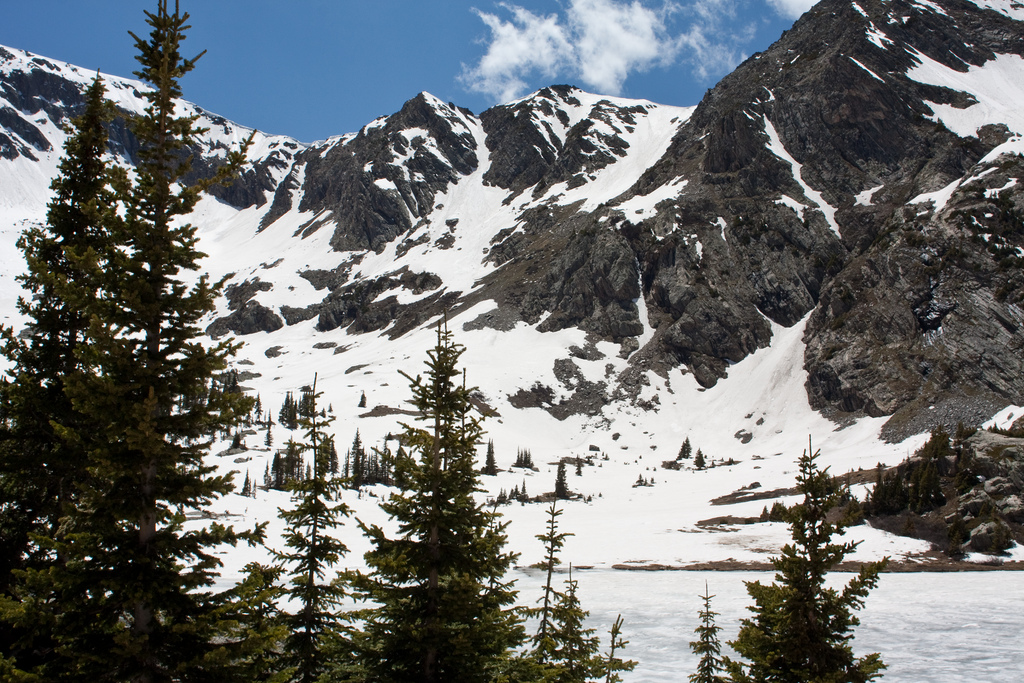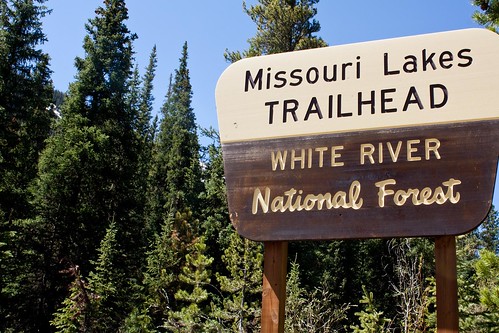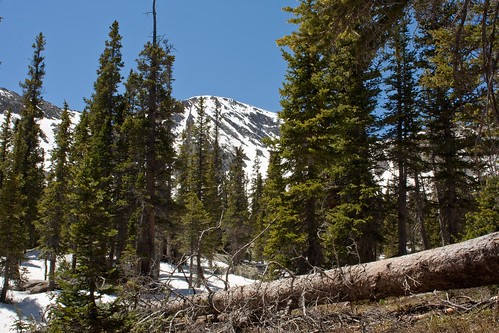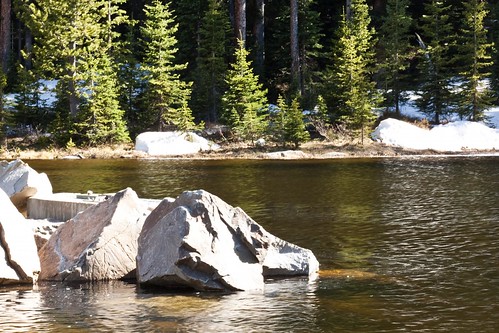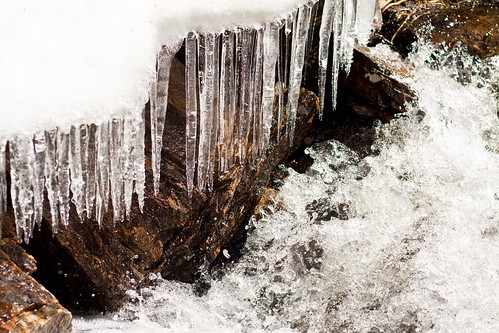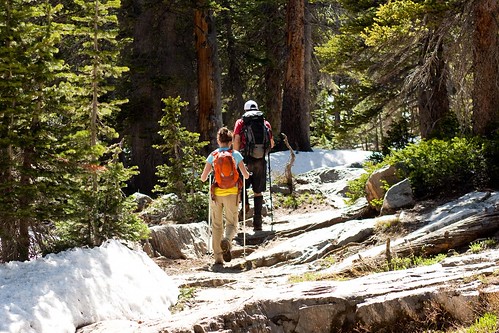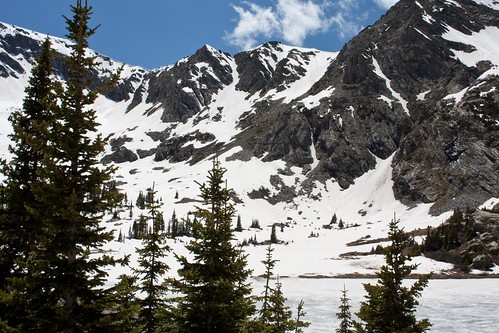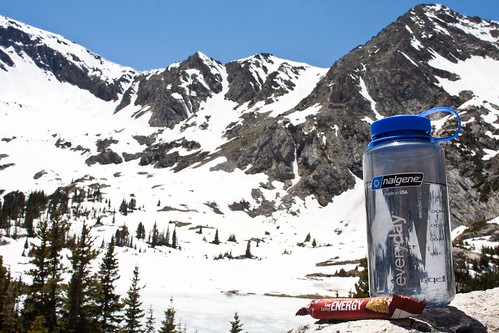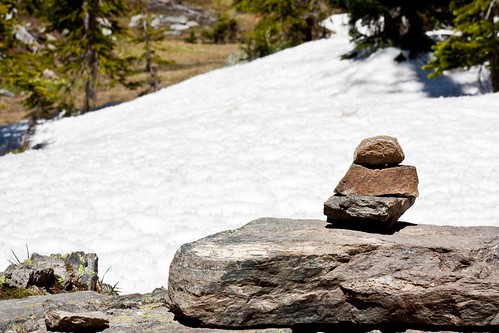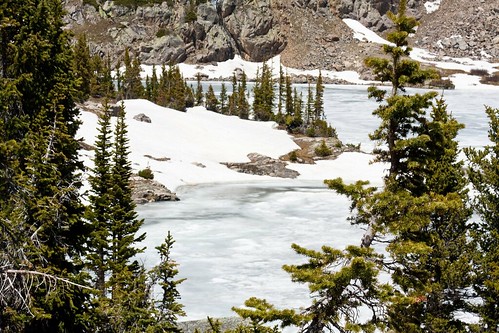(This is part of my Denver! Who knew? series. Check out the rest here.)
Sitting at the kitchen island and peering through Zach’s collection of hiking guides – ranging from Colorado’s Fourteeners all the way to The Colorado 14ers – I probably should have realized this hike would be a little different than our typical strolls through Lands End.
But, that would have required knowing what a “fourteener” was.
There are 88 peaks over 14,000 feet in the US, and Colorado has more than half of them – 53 peaks to be exact. Ticking fourteeners off your bucket list is a hobby for some, including Vice Presidential nominee Paul Ryan and apparently our friend Zach.
Vail, for a long time, seemed like a forbidding place to me. Everything I knew about these villages came from Dumb and Dumber – exclusive resorts for the extremely wealthy who had grown up going on skiing holidays. That may still be true in the winter months, but in the off season, Vail turns into a sleepy oasis of cobble stone streets, gurgling creeks, and Aspen-green scenery. With restaurants, hotels, and shops dropping their prices by sometimes 50%, you could even consider Vail a budget destination.
The village was founded as the home of Vail Ski Resort, the brain child of Pete Seibert and Earl Eaton, two veterans of the US Army’s 10th Mountain Division. Seibert was raised in a skiing family in New Hampshire; his father worked for Roosevelt’s Civilian Conservation Corps cutting ski trails. Eaton was a Colorado native, growing up in a log cabin just a few miles away; he was the first to discover Vail’s promise as a skiing destination. During World War II, both Seibert and Eaton trained at Camp Hale roughly 14 miles south of Vail along with the pioneers who would eventually found Aspen, Taos, and 60 other ski resorts around the nation.
The 10th Mountain Division got its start thanks to a private, concerned citizen: Minot “Minnie” Dole, head of the National Ski Patrol. Convinced that the US had to protect itself from German and Russian invasions in Alaska and the mountain States, Dole single-handedly persuaded the War Department to create two battalions of mountain troops, trained in skiing, bivouacking, and mountain climbing. The Division got the go-ahead to start training in 1941, first on Mt. Rainier and later in the Colorado Rockies.
After many lengthy discussions involving perceived mountain climbing abilities versus actual competence, the three of us eventually settled on a hike of the Missouri Lakes. Our white water rafting guide recommended it the day before as his favorite hike near Vail (“I don’t really bother with other trails anymore.”) It promised alpine lakes, snow-capped peaks, and waterfalls all within 3 mildly difficult miles.
Although the trail is very clearly outlined, I’d recommend heading into the mountain with someone at least kinda trained in mountain climbing. Case in point, in addition to my cute Vail outfit, my pack consisted of a Clif bar, water, extra fleece, and mittens. (Three mile hike, right?) Dave one upped me by wearing Gore-Tex hiking sneakers and bringing peanut butter sandwiches and cookies. Zach, meanwhile, sported “sweet Salomon Gore-Tex trail runners” and packed a camping stove, kettle, backpack water bladder, “sweet waterproof, tear proof regional topo map,” in addition to a variety of trail mix type food. Mountain friends are useful. And like to use the word sweet to describe their gear. At least they were also wearing shorts.
Veering off I-70 for the first time in our trip, we plunged into the quiet wilderness of the Tennessee Pass. Pine-studded peaks rose 10 to 12,000 feet on both sides of the car, eventually coming to a clear view of Mount of the Holy Cross itself.
Due to a combination of ridge lines and snowfall, Mount of the Holy Cross bears the unmistakable image of a 1,500 foot Latin cross etched into its facade. This isn’t like Jesus burned into a side of grilled cheese — no squinting or imagination is required. Back in 1944, it was also the scene of one of the most harrowing training exercises ever conducted – the D-Series.
The 10th Mountain Division’s new Camp Hale started off promising enough. Minnie Dole recruited the best and brightest skiers the US had to offer: a combination of Olympian skiers and ski jumpers in addition to Harvard and Dartmouth graduates who had spent holidays skiing in Europe. As he was quick to say, “it is more reasonable to make soldiers out of skiers than skiers out of soldiers.”
Skiing had taken off in the 1930s, in a “nationwide mania” according to Time magazine. Model T Ford engines were repurposed into ski tow generators. Skiers no longer had to climb mountains in order to ski down them, they could just get towed up a hill. New York and Los Angeles held snow-related extravaganzas, hauling in tons of crushed ice in order to wow crowds with ski jumpers, the most famous of which was a Norwegian, Torger Tokle.
Tokle now found himself performing odd jumping stunts for soldiers at Camp Hale. Also in the mix: Rupert and Werner von Trapp, who we all probably know better as Captain von Trapp’s sons Frederick and Kurt in the Sound of Music.
Film and TV crews descended on Camp Hale; soldiers, in their white camouflage uniforms and weapons, made for rugged magazine cover models. Amateur skiers sent letters home glowing, “our roster looks like a who’s who of skiing and climbing.” They walked around Camp Hale star struck.
To say the troops were mountain climbing and skiing enthusiasts would be an understatement. After weeks of mountain training, they would still spend their days skiing Ajax Mountain in Aspen. After a long day of skiing, they convened at the Jerome Hotel for something called Aspen Crud – a milkshake with a couple shots of whiskey.
Some, though, had already become “Aspen visionaries,” plotting the development of Colorado “as this country’s premier ski resort .” This isn’t completely surprising for a group of well-to-do, educated, and entrepreneurial men who would have otherwise been successful businessmen, lawyers, and doctors if not for the raging war. They spent days “at the foot of Ajax mountain, looking up and dreaming.”
Then came the D-series. In late March, with snow storms tearing through Colorado and temperatures at 30 degrees below Fahrenheit, the troops were sent on a month-long exercise to march, climb, and ski across Mount of the Holy Cross wearing 90 pound packs and surviving on a minimum of food. Later on, as German shells rained down around them in the Italian mountains, the soldiers would joke, “If this gets any worse, it’s gonna be as bad at the D-Series!”
Luckily, on this late spring day, we weren’t planning on anything remotely D-Series-esque. We arrived at the Missouri Lakes trailhead energized and excited. A brook gurgled to our left and the air smelled of strong Pine musk. (This is why some people can’t stand cities, right?)
The trouble with hiking Colorado in Spring, though, is that you never know what snow conditions are at the peaks. At the base, it was a comfortable low 70 degrees Fahrenheit. Once we were past the initial flat stretch next to Missouri Creek, the trail started climbing almost immediately. Kind of alarmingly. Zach had taken off ahead of us, no shocker there. Dave and I exchanged uneasy looks. The hike had barely started and we were already wheezing up the steep climb. We did what any rational, macho person would do: we blamed it on the altitude. “This altitude is no joke, huh?” “Yeah, it really does get to you.” The air had turned crisp. I broke out my mittens, my last, and really only, line of defense.
The trail criss-crosses the Missouri Creek as it climbs up into the Missouri Lakes Basin, with many rustic bridges leading the way. Initially, a bridge was a very exciting thing. A bridge! We’ve come across a bridge! Gird yourselves! Nine or ten bridges later, they barely registered. In the early morning sun, two-feet long icicles glistened, clinging to the sides of the cascading creek. And for some reason didn’t at all portend what the mountain had in store for us.
Only two months after the D-series and weeks after D-Day, the mountain troops received orders that they were being moved to the desert outside Austin, Texas. For flatlands training. If no part of that sentence makes sense, you aren’t alone. Needless to say, sticking a bunch of white-clad snow troops in the Texas desert prairie in the middle of Summer killed morale. In a show of small defiance, the troops voted to name their newspaper The Blizzard, featuring pin-ups of snow capped mountains in between reports from the Italian front.
They did finally get to the Italian front in January 1945, nearly 4 years after beginning training at Mount Rainier and only 4 months before the end of the war. It is unclear why the US Army had continued to use the 34th Division, with no expert training, to fight mountainous battles all along ridges in Italy against trained German mountain and ski troops. By the time the 10th Mountain Division replaced them, the 34th Division was fighting with 100% replacement troops. All the original soldiers had either been killed or wounded, roughly 16,000 men.
The 10th Mountain Division disembarked into a bomb-gutted Naples in the beginning of January – and their arrival was an ill-kept secret. In an otherwise empty city, street merchants were already set to offer the troops commemorative 10th Mountain Division rings and souvenirs, complete with the division’s new mountain logo. What didn’t arrive with them, however, was their gear. Climbing boots, skis, white camouflage parkas, sleeping bags, and all of their other tested gear had never left the port in Boston; someone in the Army’s ranks had decided the shipment was unnecessary. As the troops received orders to move to Riva Ridge in the middle of winter, the men only had their Army shoes and standard-issue Army green jackets at their disposal.
As Dave, Zach, and I continued climbing up the ridge next to the now-rushing Missouri Creek, we were momentarily too dumbfounded by the looming ice capped Savage Peak across the valley to notice the encroaching snow and ice on our path. Savage Peak isn’t that tall in the Colorado scheme of things – only 12,000 feet – but faced with its sheer white wall, it is a force to behold.
The path, meanwhile, slowly turned from frozen dirt to sloshy ice to packed snow. First only an inch thick, then a few inches thick, and next thing you know…
“POST-HOLE”
That would be Zach, relishing our newly alpine hiking adventure. Packed snow is surprisingly easy to walk on. Until it isn’t. A wrong step sent us crashing through feet of snow, up to the guys’ knees and up to my thighs. In other words, post-holing, an actual mountain climbing term of art.
In a way, my shorts were kind of perfect for this – at least I didn’t have to worry about getting snow up my pants or dealing with soggy pants, right? Which brings us to another mountain climbing term: bare-boot. To hike without use of crampons, snowshoes, skis, or other traction aids. At best, I was bare-sneakering.
With my eyes firmly planted on the shifting ground beneath me, I didn’t even realize the trail had ended about 10 yards behind us, covered by several feet of snow. Now, Dave and Zach are the types to get a little giddy when they realize they’ll have to bushwack. With relish, they approach the forest like young Indiana Jones brandishing machetes. They only needed a goblet to discover, and a woman to save.
Luckily for me and my scraped and frozen shins, we emerged above the tree line soon enough. With pine forest below us, we could finally see the blinding white tundra of Savage Peak and the Missouri Lakes laid out below.
Germany, by 1945, had completely sealed off Italy’s Po Valley from invasion. With Germany in degrees of devastation and the Allied powers pressing from the north, the Po Valley was an industrial center pressed into service for German wartime manufacturing. It was Germany’s life source.
Riva Ridge forms a nice clean line, with a nearly 40 angle façade, barricading Po Valley from the rolling hills of Tuscany to the east. German troops lining the ridge had easily held off American and Brazilian troops for months.
Army generals had essentially thrown their hands up in the air, having no idea how to surmount the ridge and eventually overtake Po Valley. When the 10th Mountain Division moved in, they wouldn’t continue the 34th Division’s attempts to attack from the side; they were told to figure out a way to climb the sheer cliff wall. And so they did.
For six weeks, with their gear still in Boston, the troops borrowed skis from Italian ski clubs, scavenged for boots, and went on night scouting missions up Riva Ridge, cutting trails into the mountain.
Five companies were selected to perform the midnight raid, including Pete Seibert’s F Company. US Army officials weren’t too optimistic; medics were told to expect a 90% casualty rate for the mission.
They set off at night with temperatures hovering below freezing at the base. Climbing in a straight line, with each soldier able to only see the person ahead of him, the troops tried to follow the trails marked by their peers only weeks before.
Oddly , even as the German troops were faced with the first American soldiers to make the ascent, they still had no idea what was happening, even failing to warn other camps of the impending battle. The German POW’s were stunned; they had figured the eastern side of Riva Ridge to be impenetrable. Within a day, the battle for Riva Ridge would be over, with only 17 American soldiers killed.
Standing at the spectacular overlook to Savage Peak, Dave picked out a rocky outcropping for our lunch spot. There is something meditative about a moutain wall; each of us ate in silence staring at crevices, ridges, wondering about a change in snow cover towards the highest ridge. We slowly began picking out smooth lines cut into the mountain side — ski trails? It turns out, yes, that’s exactly what they were. People actually do climb these peaks, some of them even wearing shorts and Teva sandals, with skis strapped to their backs. When you’re a girl who grew up on the flat concrete of Philadelphia, this is mindblowing.
The landscape was wide open, with peaks in every direction and the sun shining down from a cloudless blue sky. After basking on the rocks for a few minutes longer, we were back on the non-trail to find the remaining Missouri Lakes. We didn’t get far before a curious marmot ran out from under the brush and stopped to stare.
Marmots are the patron mammal of mountain climbers everywhere. “After you’ve been climbing all day, and you kind of start feeling lonely out here by yourself, it’s always nice to see the little guys out on the trail,” Zach whispered. The four of us stared at each other a while longer, until the marmot had his fill and just ask quickly, rushed back into the brush. We resumed plowing through the snow, the marmot behind us stealing a few more peaks in our wake.
Despite the accomplishments at Riva Ridge, this was really only the first battle for the 10th Mountain Division. It was one of the few chances for their mountaineering skills to be put to the test, but it was actually the easiest of the battles the division would see. Surrounding ridge lines still had to be captured, and now with a somewhat tipped off enemy.
The Germans fled down the smooth west bank of Riva Ridge, leaving landmines in their wake. The 10th Mountain Division’s engineers, after successfully constructing a tramway on Riva Ridge to take artillery and wounded soldiers up and down the ridge, had to change direction and begin disarming trip wires and underground holes filled with dynamite and capped off with landmines. Over the course of the next few months, the Division led the push, moving the Germans north to the Alps. With secrecy no longer an issue, the soldiers were surrounded in the cacophony of war, with fighter airplanes flying overhead and dropping bombs on the front lines. Their mountaineering adventures were over; this was now all out war.
Turning around the bend, we finally came to the largest of the Missouri Lakes, a wide crystalline swath of blue ice. With crisp peaks surrounding us and the frozen lake beds below, the air was still, with only our breath to disturb it. My socks were soaked, my knees scraped from our off trail hiking, my ankles red and swollen with snow, but I wouldn’t notice it until we were back at the car and Dave asked, “what happened to you?!” We were all in our own moment up there in the alpine basin, overwhelmed with calm tranquility.
I suddenly got why people do this – the drudgery of climbing thousands of feet in deep snow, lips chapped, eyes blurred from the glaring sun, packs weighed down with ski boots – and I wanted more. I wanted higher. I wanted steeper.
After months of battling north through the Po Valley, the mountain troops felt re-energized at their first siting of the Alps. Some even looked forward to taking the battle into the hills again. Fortunately for the rest of the world, Hitler was now dead and the German army was surrendering in droves.
Of course, they went into the Alps anyway. “Borrowing” skis from Axis warehouses, troops climbed up into the Alps and skied some of the finest mountains they’d ever seen. There was still some business to conduct back at their base – guarding German POWs, preparing for a possible deployment to the Pacific theatre – but in their free time, the troops did just as they did back at Camp Hale. They looked into the mountains and dreamed.
****************************************
End Note: The 10th Mountain Division’s troops would not only build Vail, but also Aspen, Taos, and 60 other ski resorts around the country. Their alumni include Senator Bob Dole (who received two Purple Hearts and a Bronze Metal for saving a radioman in his platoon), the co-founder of Nike, heads of the Sierra Club, Olympians, US Olympic team coaches, and congressmen. The Division still exists today, most recently having fought in the remote mountains of Afghanistan near the Pakistani border.
————————————————————————————-
What: The Missouri Lakes Trail in the Holy Cross Wildnerness Area
How to Get There: Drive west from Vail on I-70, take the exit onto US 24 West. Turnoff off onto Homestake Road in roughly 12.6 miles. There is a US Forest Service sign for Homestake Road, but you should keep an eye on the odometer to make sure you don’t miss it. Drive along Homestake Road to the Missouri Lakes trail head.
To check in on Camp Hale, continue driving south on Homestake Road for a few miles. Keep in mind that the camp no longer exists, but you may see a clearing on your left.
When to go: Highly recommend getting an early start to your day. Snow will still be around in late May and June.
What to bring: Hiking boots/sneakers. Gore-tex recommended. At least three layers of clothing — it’s cold. Gloves and ski hats. Food and water. You should probably be responsible and bring a topography map of the trail and whistle.






